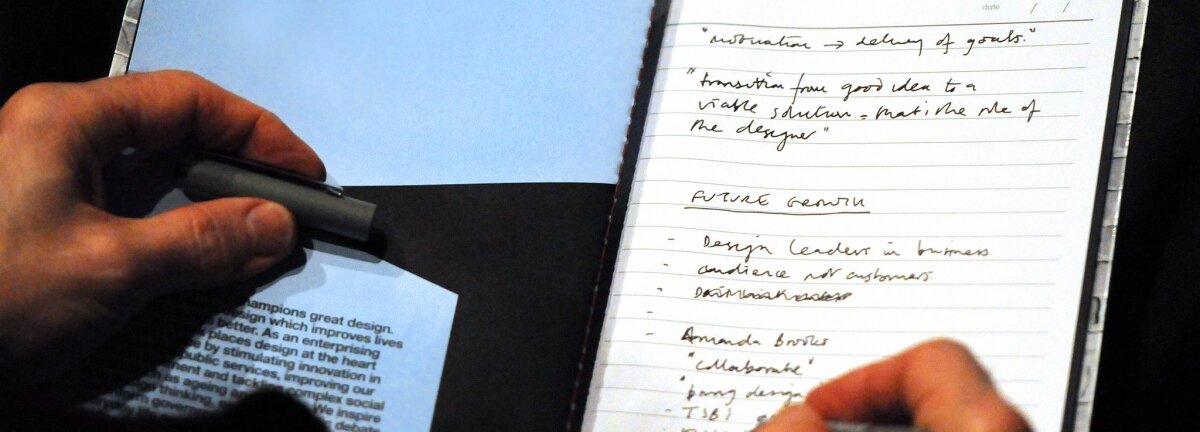What I learned at Leading Business by Design

We invited design blogger Katie Treggiden along to our Leading Business by Design summit at the British Museum to get her take on what design can offer businesses.
The Design Council research and summit, Leading Business by Design, set out to explore how design can be used to make a difference in business. If asked to sum up the findings in six words, the words I’d choose would be those of digital designer and author of The Shape of Design, Frank Chimero: “people ignore design that ignores people”. Luckily I’ve got 600 words, so I’ll elaborate.
There is plenty of evidence that design makes a difference. During the summit Jeremy Lindley of Diageo, said, “The redesign of Johnnie Walker Blue Label, led to sales growth of over 25%” while Nigel Oseland from Workplace Unlimited, said, “There is clear evidence that workplace design has an impact on performance and productivity.”
We’re using co-design principles – with people, for people. Services people don’t want to use are a waste of public money.
Arren Roberts, Shropshire Council
When you think of good design you tend to think of products and perhaps branding. You might think of designers like Jonathan Ive. You probably don’t think of the CEO, the end-user or the finance department. Yet the most interesting insights were about the role ordinary people play in successful design. As Arren Roberts, Shropshire Council, put it, “What I’m going to talk about is people, because that’s what it’s really about.”
Good design puts the user at the centre. Talking about GOV.UK, the Design Museum’s 2013 Design of the Year, Martha Lane Fox said “The impact is most strong when you look at how it puts users at the heart of services. There’s been a quiet revolution in government to see the citizen at the heart of what’s done.”
Matt Webb – CEO, BERG
BERG CEO Matt Webb said, “You need to have empathy with the people who are going to be using what you’ve made. Understanding customers should be something people swim in while they’re having ideas.” Taking that further he said, “By leaving ‘the wires hanging out of the back,’ we discovered what people would use Little Printer for… and that’s the bit we’re commercialising.”
Our mantra used to be ‘Good is the enemy of great,’ but getting something good out into the wild and then optimising it based on how people react is becoming the norm.
Mel Exon, BBH
Mel Exon, BBH, echoed this: “Our mantra used to be ‘Good is the enemy of great,’ but getting something good out into the wild and then optimising it based on how people react is becoming the norm.” Arren Roberts said, “We’re using co-design principles – with people, for people. Services people don’t want to use are a waste of public money.”
Mel Exon – Chief Digital Officer, BBH
Leadership support is also crucial. Martha Lane Fox attributed founder-company success to strong design leadership, saying, “I can’t think of a founder who isn’t absolutely obsessed with design.” Jonathan Ball, Design Council, talked about not just creating time and space for design, but also giving permission. Pietro Micheli, Warwick Business School, said, “Understand that to some extent we need to trust designers and measure the effect afterwards.”
The importance of design in working environments was another theme. Luke Miles, Virgin Atlantic said, “Our product isn’t the aircraft, it’s the journey. At the heart of that are people – how they feel when they come to work is infinitely tied to our customers’ experience. So we’re redesigning spaces for crew.” Psychologist and neuroscientist Molly Crocket talked about the importance of removing barriers to wellbeing, citing fellow speaker Richard Baldwin’s Derwent examples of a running track on the roof of the White Collar Factory and simple steps such as not hiding the stairs.
Finally, the role of designers themselves was discussed. Pietro Micheli said, “Are they just good designers? No. They try to make people aware of the benefits of design.” Jonathan Ball, emphasised the importance of the team – not just original thinkers, but also ‘do-ers’, ‘motivators’ and ‘completer-finishers’. Arren Roberts said “Why designers? I think [Liverpool Council] wanted people who could be a bit disruptive, bring energy and enthusiasm, and hold up an honest mirror.” Because good design it seems is more about people than it is about things.
Subscribe to our newsletter
Want to keep up with the latest from the Design Council?
